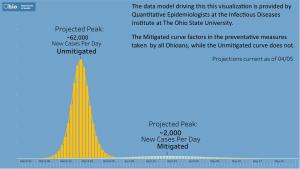As citizens around the world first caught wind about the COVID-19 virus, almost no one predicted that it would become an international pandemic with such far-reaching effects. Wasiur KhudaBukhsh, a president’s postdoctoral scholar at the Mathematical Biosciences Institute at The Ohio State University, was no exception.
“I was in Marseilles, France in February this year and there was a conference about infectious diseases. We were discussing all sorts of methodology, state of the art techniques, and we also discussed COVID-19. But back then, it was considered to be an epidemic in the Wuhan province in China. It was not yet a pandemic,” said KhudaBukhsh.
Soon after returning from France, many parts of the United States entered into a lockdown due to the rapid spread of the virus within the country. This led a team of researchers, headed up by Dr. Joseph Tien of Ohio State, to begin modeling the spread of the virus within the state of Ohio. After reaching out to the Ohio Department of Health to determine how the team could help state agencies make data-informed decisions and come up with public health interventions regarding the virus, they soon realized that the volume of data they were dealing with would require the use of a supercomputer.
Dr. Tien noticed the special announcement on the Ohio Supercomputer Center’s (OSC) website stating that researchers involved in COVID-19 research projects would be given priority, unbilled access to computational and storage resources. After a proposal was submitted and quickly approved, the team was able to get to work.
“I was responsible for generating statewide predictions of new cases of COVID-19,” said KhudaBukhsh. “There was no fixed methodology in place because this pandemic is so different from any other in history because people are changing their behavior. There was lockdown and then all sorts of other things. Even if you look at the curve from a scientific standpoint, it's very different from other things. So, we were running those computations all the time.”

Models produced by KhudaBukhsh’s team were featured on the press conferences conducted by Governor Mike DeWine and former Director of the Ohio Department of Health Dr. Amy Acton. As time progressed, the research questions surrounding the virus changed to focus on how to best advise the state on safe reopening practices after the initial lockdown period and then how to handle a second surge of the virus.
“OSC has been instrumental. Without OSC, we couldn’t have done what we did. And going forward, although our research questions are changing and the demands from our state partners are changing, we’re still doing a lot of different kinds of modeling for COVID-19,” said KhudaBukhsh. “We want to make sure our conclusions are scientifically robust, regardless of the methodology.”